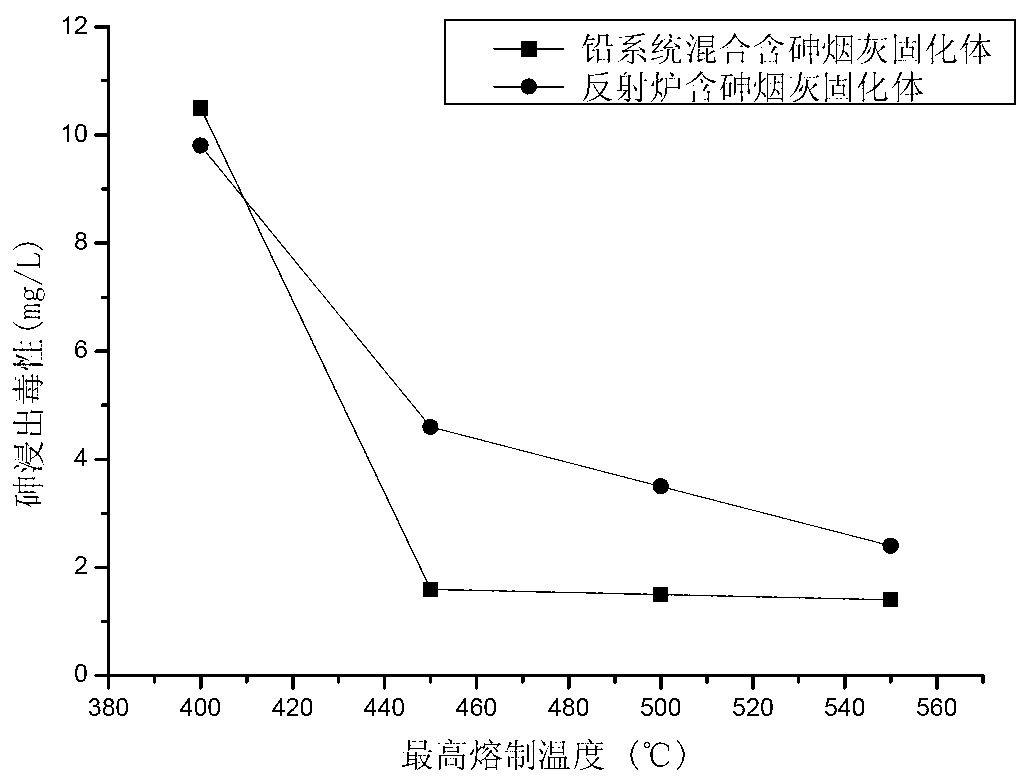Arsenious waste curing method as well as generated solid arsenic crystal product and application thereof
A technology for arsenic waste and waste, which is applied in the field of arsenic-containing waste treatment, can solve the problems of low arsenic solidification rate and cured products that cannot be used as resources, and achieve good arsenic fixation effect, compact structure, and high-efficiency stable transformation. Effect
- Summary
- Abstract
- Description
- Claims
- Application Information
AI Technical Summary
Problems solved by technology
Method used
Image
Examples
Embodiment 1
[0042] The method for curing arsenic-containing waste in this embodiment (process flow chart is as follows figure 1 shown) includes the following steps:
[0043] (1) Grind the synthesized iron-arsenic precipitate (containing about 70% scorodite and 39% arsenic content), pass it through a 4-mesh sieve, and take 68.9g to mix with iron-boron-phosphorus basic glass batching H 3 BO 3 5.67g, P 2 o 5 31.79g, K 2 CO 3 1.96g, Na 2 CO 3 7.34g, arsenic stabilizer kaolin 12.4g (sorodite can be decomposed to produce Fe 2 o 3 , so there is no need to add network intermediates) after mixing evenly, dry it in a constant temperature oven at 60°C until the moisture content is 8%.
[0044] (2) Put the dried raw materials in a stainless steel mold (the inner wall of the stainless steel mold is coated with a layer of glass release agent), and then put it into a programmable hot-press sintering furnace, and keep the furnace temperature at a constant speed for 0.8h Raise to 450°C, and then...
Embodiment 2
[0049] The method for curing arsenic-containing waste in this embodiment (process flow chart is as follows figure 1 shown) includes the following steps:
[0050] (1) Mix arsenic-containing soot (4.6% arsenic content) from a lead smelting system in a smelter, grind it, pass through a 4-mesh sieve, and take 73.5g of it to mix with iron-boron-phosphorus basic glass ingredient H 3 BO 3 2.32g, P 2 o 5 18.62g, Fe 2 o 3 3.59g, K 2 CO 3 0.52g, Na 2 CO 3 1.19g and 5.25g of arsenic stabilizer CaO are mixed evenly and then dried in a 90°C thermostat until the moisture content is 5%.
[0051] (2) Put the dried raw materials into a stainless steel mold, then put them into a programmable hot-press sintering furnace, raise the temperature of the furnace to 450°C at a constant speed for 0.8h, and then keep it at this temperature for 2h. During the process, the internal pressure of the stainless steel mold is always maintained at 12MPa. After melting and homogenizing, it is naturally...
Embodiment 3
[0056] The method for curing arsenic-containing waste in this embodiment (process flow chart is as follows figure 1 shown) includes the following steps:
[0057] (1) Grind the polluted acid slag (28.8% arsenic content) from a smelter, pass it through a 4-mesh sieve, and take 39.9g of it to be mixed with the basic glass ingredient H of the iron-boron-phosphorus system 3 BO 3 4.87g, P 2 o 5 33.44g, Fe 2 o 3 9.42g, K 2 CO 3 2.71g, Na 2 CO 3 4.16g, arsenic stabilizer CaCO 3 10.5g was mixed evenly and then dried in a constant temperature oven at 65°C until the moisture content was 7%.
[0058] (2) Put the dried raw material into a stainless steel mold, then put it into a programmable hot-press sintering furnace, raise the temperature of the furnace to 400°C at a constant speed for 0.8h, and then keep it at this temperature for 1.2h. Keep the pressure at 11MPa during the heating process. After melting and homogenizing, cool down to room temperature naturally in a hot-pres...
PUM
| Property | Measurement | Unit |
|---|---|---|
| mechanical strength | aaaaa | aaaaa |
| strength | aaaaa | aaaaa |
| strength | aaaaa | aaaaa |
Abstract
Description
Claims
Application Information
 Login to View More
Login to View More - R&D
- Intellectual Property
- Life Sciences
- Materials
- Tech Scout
- Unparalleled Data Quality
- Higher Quality Content
- 60% Fewer Hallucinations
Browse by: Latest US Patents, China's latest patents, Technical Efficacy Thesaurus, Application Domain, Technology Topic, Popular Technical Reports.
© 2025 PatSnap. All rights reserved.Legal|Privacy policy|Modern Slavery Act Transparency Statement|Sitemap|About US| Contact US: help@patsnap.com



